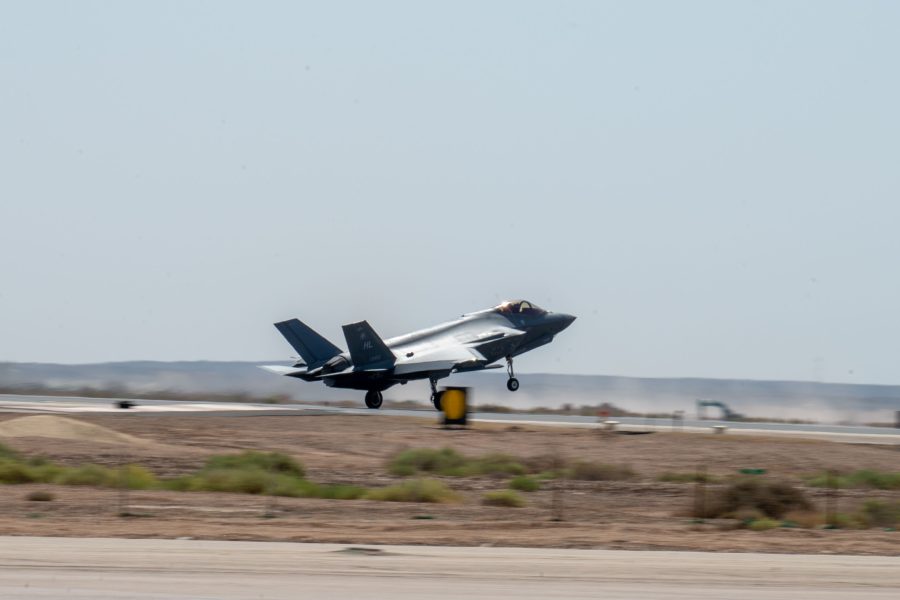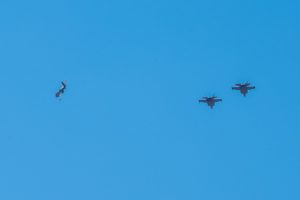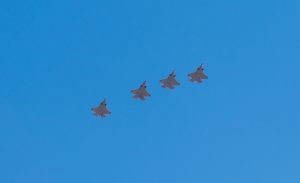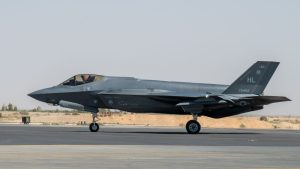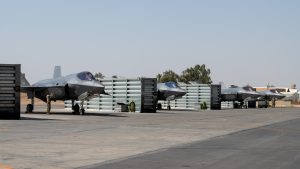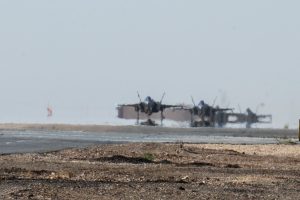A dozen U.S. Air Force F-35s have arrived in the Middle East to beef up U.S. Central Command’s airpower in the region and deter Iran from seizing oil tankers near the Strait of Hormuz, the service announced July 26.
The deployment of the aircraft also comes as Russian fighters have stepped up their harassment of U.S. aircraft over Syria.
“The F-35’s increased capacity and capability will allow the U.S. to fly in contested airspace across the theater if required,” Air Forces Central (AFCENT) spokesman Col. Mike Andrews said in a statement.
The F-35 deployment was first announced last week by the Pentagon as part of a package of forces heading to the region, including a destroyer and the USS Bataan amphibious assault ship with U.S. Marines after Iran attempted to seize commercial vessels near its waters earlier this month.
Since then, U.S. forces have had yet more run-ins with Russians over the skies of Syria. On July 23, a Russian Su-35 fighter unleashed flares that damaged a propeller blade on an American MQ-9 drone. The episode was similar to one in March when a Russian fighter crashed into a U.S. MQ-9 over the Black Sea, forcing U.S. operators to down the Reaper in the sea, according to the Pentagon. On July 26, another Russian fighter damaged an American drone over Syria with flares, U.S. officials said. The Associated Press first reported the July 26 incident.
A U.S. official told Air & Space Forces Magazine that the Russian fighter was intentionally trying to damage the U.S. MQ-9 on July 23.
There have been other confrontations over Syria as well. Earlier in the month, a Russian fighter flew near a U.S. turboprop MC-12, endangering the lives of the four crew members when the plane was caught in the fighter’s jet wash, according to AFCENT commander Lt. Gen. Alexus G. Grynkewich.
Russia also flew a surveillance plane of its own, an An-30, over the U.S. military’s Al Tanf garrison in eastern Syria for a prolonged period earlier this month. The U.S. did not have a fighter presence up over base at that time. The F-35s will aid the Air Force’s ability to respond to threats throughout the region, U.S. officials said.
The F-35 deployment consists of a squadron of stealthy multirole fighters from the 421st Expeditionary Fighter Squadron out of Hill Air Force Base, Utah. There are now four fighter squadrons in CENTCOM: two F-16 squadrons, one A-10 squadron, and one F-35 squadron.
“This deployment demonstrates the U.S.’s commitment to ensure peace and security in the region, through maritime support and support to the coalition’s enduring mission to defeat ISIS in Syria,” Andrews said.
Air Forces Central declined to say which locations the F-35s are operating from or discuss the length of the deployment, citing “host nation requests” and operational security.
Over Syria, the F-35s could aid the USAF by conducting defensive counter-air missions or combat air patrols.
The U.S. has roughly 900 troops in Syria and partners with Kurdish groups to defeat the remnants of ISIS. U.S. aircraft support the effort by providing intelligence, surveillance, and reconnaissance, force protection, and airstrikes, including one by an MQ-9 on July 7 that killed an ISIS leader in western Syria as he was riding on his motorcycle.
Russia is in Syria supporting the regime of Bashar Al-Assad.
In recent months, however, MQ-9s operating against ISIS have been harassed by Russian aircraft, even though ISIS is ostensibly a common foe. In November 2022, a Russian-controlled surface-to-air missile fired at a U.S. drone, in addition to the most recent incidents.
U.S. officials have charged that recent Russian aerial actions over Syria complicate the fight against ISIS.
“We do not seek escalation; we do not seek war with Russia,” deputy Pentagon Press Secretary Sabrina Singh told reporters July 25. “But there’s no excuse for Russian forces’ continual harassment of our MQ-9s, especially after years of operating within the region and after years of also being very clear on what our goals are, which is the enduring defeat of ISIS.”
Meanwhile, Iran has stepped up its attempts to seize oil tankers as they transit the Strait of Hormuz, a strategic choke point between the Arabian Gulf and the Gulf of Oman through which roughly 20 percent of the world’s oil flows.
That prompted the Pentagon to add F-16s to the A-10s that were originally aiding the U.S. Navy in patrolling the skies over the Gulf.
“In coordination with our regional allies, partners, and the U.S. Navy, the F-35s will partner with A-10s and F-16s already in theater helping monitor the Strait of Hormuz,” Andrews said.
On July 23, Iran said it was commencing an annual air force drill. State media said more than 90 fighters, bombers, and drones were participating in the exercise, called “Devotees of the Supreme Leader-11.” One U.S. official described coordination between Iran and Russia in the region as “covert.”
Editor’s Note: This story was updated with details of a July 26 incident between Russian and American aircraft.
